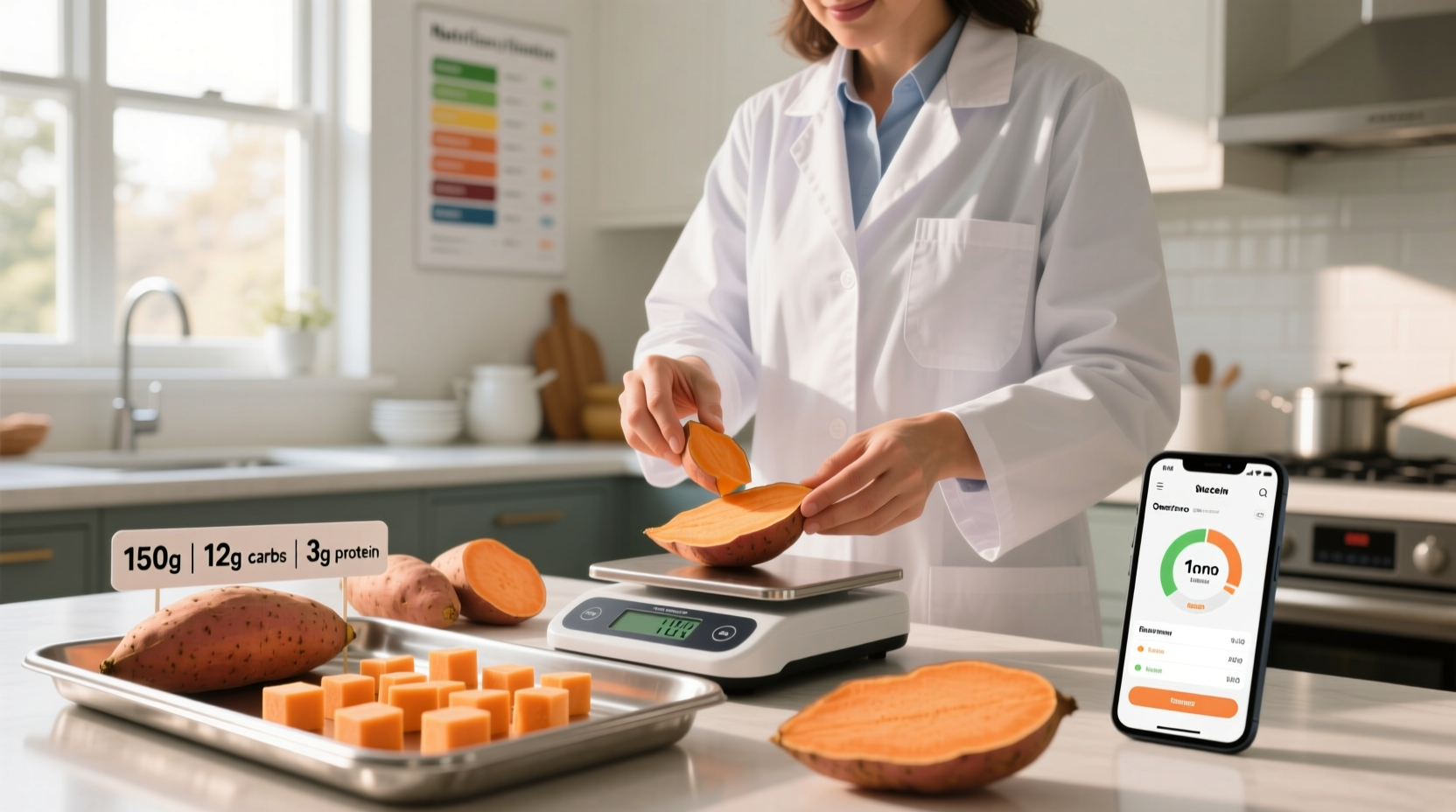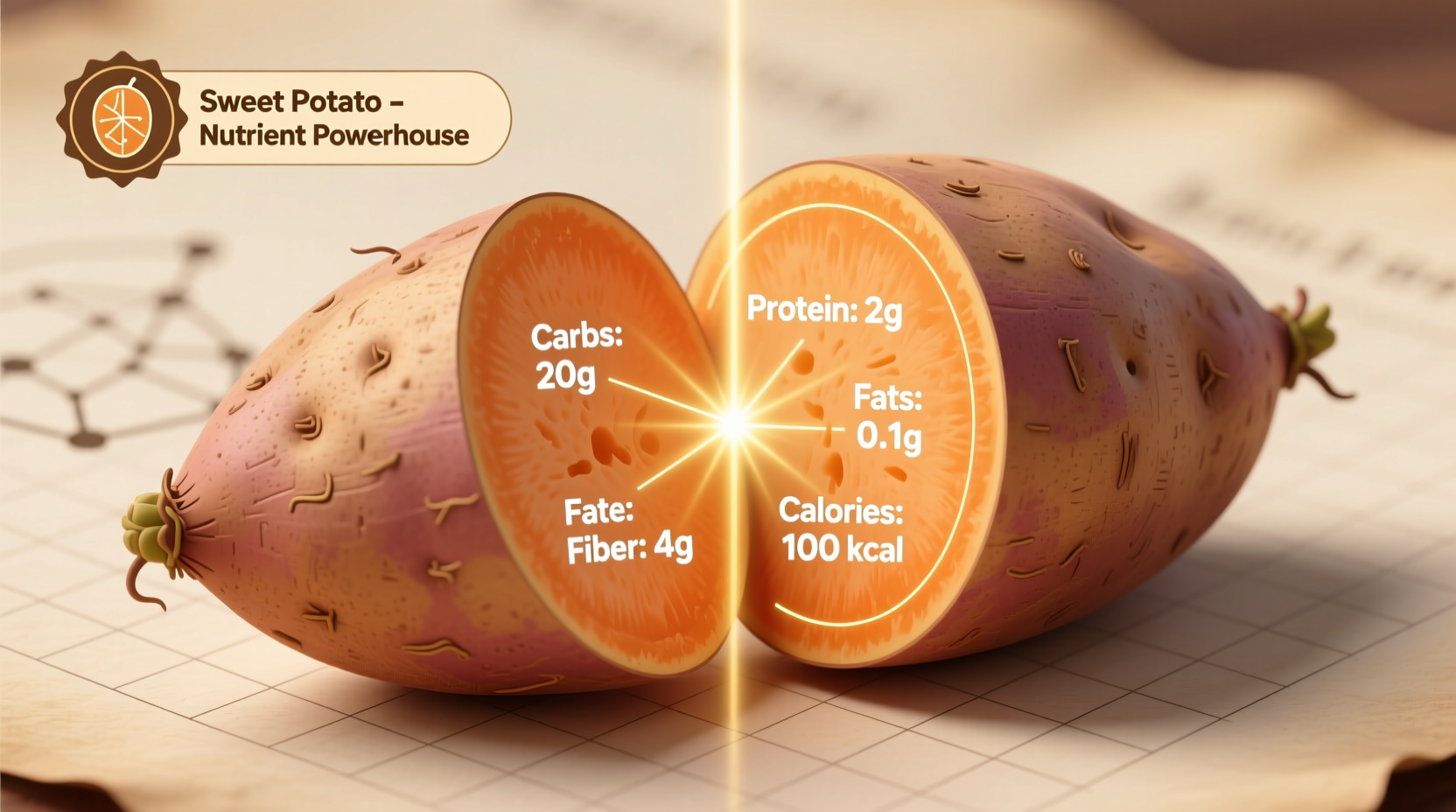One medium sweet potato (130g) contains 112 calories, 26g carbohydrates (including 4g fiber and 7g sugar), 2g protein, and 0.1g fat. It's exceptionally rich in vitamin A (providing 438% of your daily value) and offers significant potassium and vitamin C.
Understanding sweet potato macros is essential for anyone tracking their nutrition, whether you're an athlete optimizing performance, managing blood sugar levels, or simply making informed dietary choices. This comprehensive guide delivers precise nutritional data backed by authoritative sources, practical preparation tips, and clear guidance on incorporating sweet potatoes into various eating patterns.
Sweet Potato Macronutrient Profile: The Complete Breakdown
When evaluating sweet potato macros, it's crucial to understand both the quantitative values and their practical implications for your diet. The USDA FoodData Central database provides the most reliable nutritional information for raw sweet potatoes, which changes slightly based on preparation method.
| Nutrient | Per 100g Raw | Per Medium (130g) | % Daily Value* |
|---|---|---|---|
| Calories | 86 | 112 | - |
| Total Carbohydrates | 20.1g | 26g | 9% |
| Dietary Fiber | 3.0g | 4g | 14% |
| Sugars | 4.2g | 7g | - |
| Protein | 1.6g | 2g | 4% |
| Total Fat | 0.1g | 0.1g | 0% |
| Vitamin A | 14,187 IU | 18,443 IU | 438% |
| Vitamin C | 2.4mg | 3.1mg | 5% |
| Potassium | 337mg | 438mg | 12% |
*Based on a 2,000 calorie diet. Source: USDA FoodData Central
How Cooking Methods Affect Sweet Potato Macros
The way you prepare sweet potatoes significantly impacts their nutritional profile and glycemic response. Understanding these changes helps you make informed decisions based on your dietary goals.
Baking concentrates natural sugars through caramelization, slightly increasing calorie density per volume while enhancing flavor complexity. Boiling leaches some water-soluble nutrients into the cooking water but preserves more vitamin C compared to baking. Steaming offers a middle ground, maintaining most nutrients while improving digestibility.
Research published in the Journal of Agricultural and Food Chemistry confirms that cooking sweet potatoes increases their antioxidant availability, particularly beta-carotene, which converts to vitamin A in your body. This means cooked sweet potatoes actually provide more usable vitamin A than raw ones, despite minor nutrient losses during cooking.

Sweet Potatoes Compared to Other Starchy Vegetables
When evaluating sweet potato macros in context, comparison with similar foods provides valuable perspective for meal planning. This comparison helps determine which starchy vegetable best serves your specific nutritional needs.
| Food (100g) | Calories | Carbs | Fiber | Glycemic Index | Key Nutrients |
|---|---|---|---|---|---|
| Sweet Potato | 86 | 20g | 3g | 44-94* | Vitamin A, Vitamin C, Potassium |
| White Potato | 77 | 17g | 2.2g | 58-111* | Potassium, Vitamin C, B6 |
| Butternut Squash | 45 | 12g | 2g | 51 | Vitamin A, Vitamin C |
| Beets | 44 | 10g | 2.8g | 64 | Folate, Manganese, Potassium |
*Glycemic Index varies significantly based on cooking method and variety. Source: National Center for Biotechnology Information
Strategic Timing: When to Eat Sweet Potatoes for Your Goals
The timing of sweet potato consumption can optimize their nutritional benefits based on your specific objectives. Understanding sweet potato macros helps you strategically incorporate them into your meal plan.
For Athletes and Active Individuals: Consume sweet potatoes 1-2 hours before workouts for sustained energy release. Their complex carbohydrates provide steady fuel without the blood sugar spikes associated with simple sugars. Post-workout, pair sweet potatoes with protein sources to enhance glycogen replenishment and muscle recovery.
For Blood Sugar Management: Pair sweet potatoes with healthy fats (like olive oil or avocado) and protein to slow carbohydrate absorption. Research from the American Diabetes Association indicates that consuming sweet potatoes with fat reduces their glycemic impact by up to 30% compared to eating them alone.
For Weight Management: Include sweet potatoes as part of balanced meals rather than as standalone snacks. Their high fiber content promotes satiety, helping you feel full longer. A study in the Nutrition Journal found that participants who included sweet potatoes in their meals reported 22% greater fullness compared to those eating white potatoes.
Practical Tips for Maximizing Sweet Potato Nutrition
Implement these evidence-based strategies to get the most nutritional value from sweet potatoes while aligning with your dietary goals:
- Don't peel them: The skin contains nearly half the fiber and significant antioxidant compounds. Simply scrub thoroughly before cooking.
- Cool before eating: Allowing cooked sweet potatoes to cool increases resistant starch content, which functions as prebiotic fiber supporting gut health.
- Pair with healthy fats: Vitamin A absorption increases by up to 50% when sweet potatoes are consumed with fats like olive oil or avocado.
- Portion mindfully: A medium sweet potato (130g) provides appropriate carb levels for most meal plans, while larger varieties can double the carbohydrate content.
- Store properly: Keep in a cool, dark place (not refrigerated) to preserve nutrient content and prevent sprouting.
When Sweet Potatoes Might Not Fit Your Diet
While sweet potatoes offer numerous benefits, they may not suit every dietary approach. Understanding these context boundaries helps you make informed choices:
Ketogenic Diets: With approximately 20g of net carbs per 100g, sweet potatoes typically exceed keto carb limits. Those following strict keto (20-50g net carbs daily) should limit or avoid sweet potatoes. Some modified keto approaches might include small portions (50g) occasionally.
Certain Autoimmune Protocols: Some elimination diets like AIP (Autoimmune Protocol) restrict nightshades and sometimes sweet potatoes during initial phases, though they're often reintroduced later.
Specific Digestive Conditions: Individuals with FODMAP sensitivities may need to limit sweet potato portions, as they contain moderate levels of mannitol, a sugar alcohol that can trigger symptoms in sensitive individuals.
Common Questions About Sweet Potato Macros
These frequently asked questions address the most common concerns people have when incorporating sweet potatoes into their nutrition plans:
How many net carbs are in a sweet potato?
A medium sweet potato (130g) contains approximately 22g net carbs (total carbs minus fiber). This calculation comes from 26g total carbohydrates minus 4g fiber. Net carbs matter most for those tracking carbohydrate intake for blood sugar management or specific dietary approaches like keto.
Are sweet potatoes good for weight loss?
Yes, sweet potatoes can support weight loss when consumed as part of balanced meals. Their high fiber content (4g per medium potato) promotes satiety, helping you feel full longer. Research shows that sweet potatoes have a lower glycemic index than white potatoes, resulting in more stable blood sugar levels that reduce cravings. For weight management, pair sweet potatoes with protein and non-starchy vegetables while monitoring portion sizes.
Do sweet potatoes have more sugar than white potatoes?
Sweet potatoes contain more natural sugars than white potatoes (7g vs 0.8g per medium potato), but they also have significantly more fiber and a lower glycemic index when prepared properly. The sugar in sweet potatoes comes with valuable nutrients like vitamin A and fiber, making them a more nutritionally complete carbohydrate source. When consumed with the skin and paired with healthy fats, sweet potatoes cause a more gradual blood sugar rise than white potatoes.
How do sweet potato macros change when baked versus boiled?
Baking concentrates sweet potato macros slightly due to water loss, increasing calorie density per volume (about 90 calories per 100g baked vs 86 raw). Boiling leaches some water-soluble nutrients into the cooking water but preserves more vitamin C. Both methods increase the availability of beta-carotene (which converts to vitamin A). From a macro perspective, the differences are minimal - focus more on portion control and what you pair with your sweet potato rather than the cooking method alone.
Can diabetics eat sweet potatoes?
Yes, diabetics can include sweet potatoes in their diet with proper portion control and preparation methods. Sweet potatoes have a moderate glycemic index (44-94 depending on variety and cooking method), lower than white potatoes. Research from the American Diabetes Association shows that consuming sweet potatoes with healthy fats reduces their glycemic impact by up to 30%. Diabetics should limit portions to 1/2 cup cooked (about 80g) and pair with protein and non-starchy vegetables for balanced blood sugar response.











 浙公网安备
33010002000092号
浙公网安备
33010002000092号 浙B2-20120091-4
浙B2-20120091-4